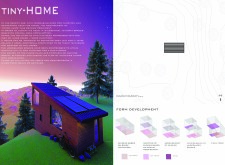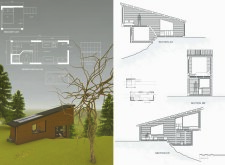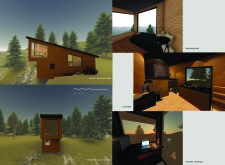5 key facts about this project
The Tiny Home project is situated in the hills of Shimla, Himachal Pradesh, where it aims to meet the needs of modern living through an innovative approach to compact housing. Designed to optimize functionality within a small footprint, the concept embraces the idea of "less space + more function." This design effort combines comfort and practicality, providing a meaningful solution for those seeking efficient living arrangements in a smaller setting.
Design Concept
The vision for the Tiny Home focuses on maximizing space while ensuring easy movement throughout the interior. Each area serves a specific purpose and is organized into semi-public, semi-private, and private zones. This layout encourages both social interaction and personal retreat, allowing for a balanced living experience. By thoughtfully arranging spaces, the design enhances everyday life in a compact home.
Materials and Construction
Natural materials have been chosen for their connection to the environment. Deodar and chir wood are key components of the structure, providing strength and sustainability. The warmth of the wood creates a welcoming atmosphere, while also blending the home with its hillside surroundings. The construction details show a clear understanding of practical building techniques, resulting in a sturdy design that does not compromise on quality.
Spatial Layout
The floor plan is centered on efficiency by reducing unneeded areas. It combines living, dining, working, and kitchen spaces in a way that allows for easy movement from one area to another. This thoughtful organization helps residents navigate their home comfortably. The layout supports a high-quality living experience, even within the confines of a small environment.
The exterior elevations of the Tiny Home present a straightforward yet thoughtful design, reflecting a strong connection to the natural landscape. The roof and wall details highlight the construction methods used, creating a structure that integrates well with its surroundings. The design achieves a balance between functionality and aesthetics, resulting in a practical interpretation of micro-living that meets contemporary needs.






















































